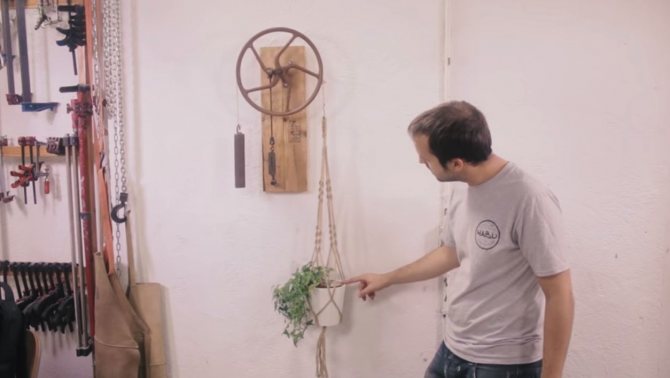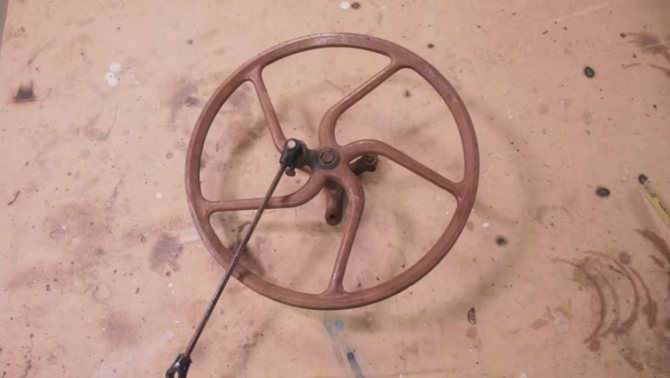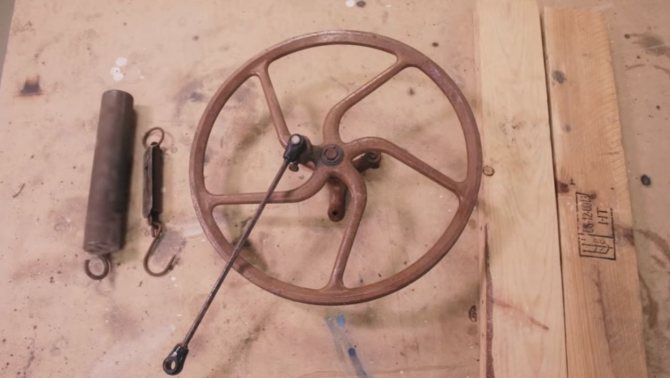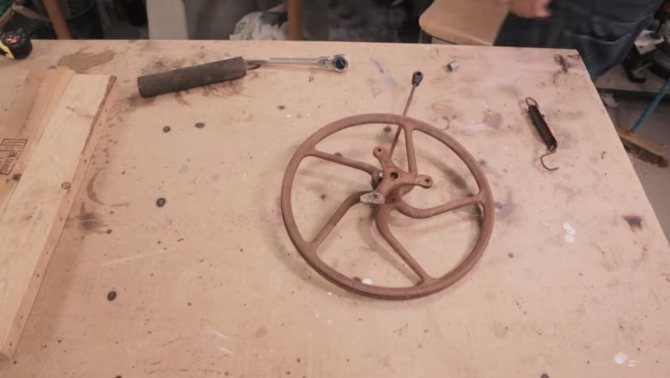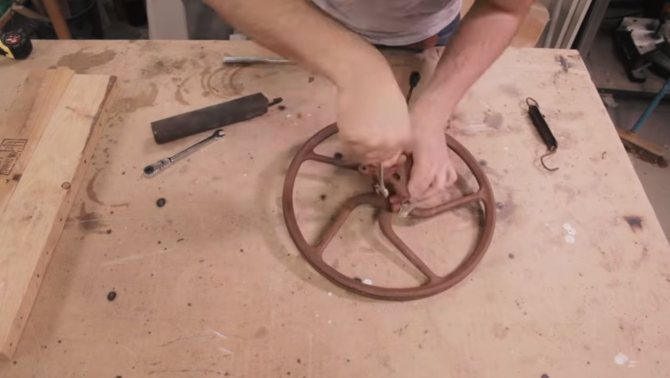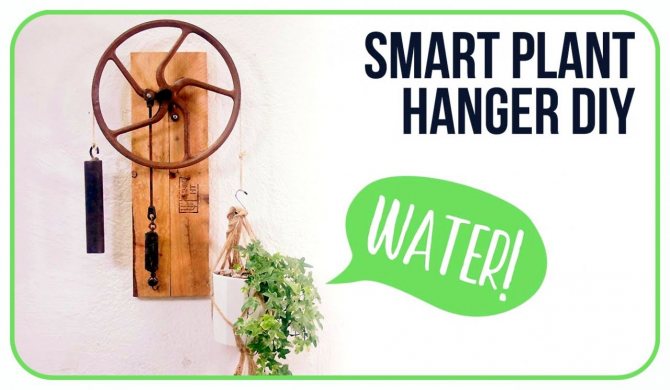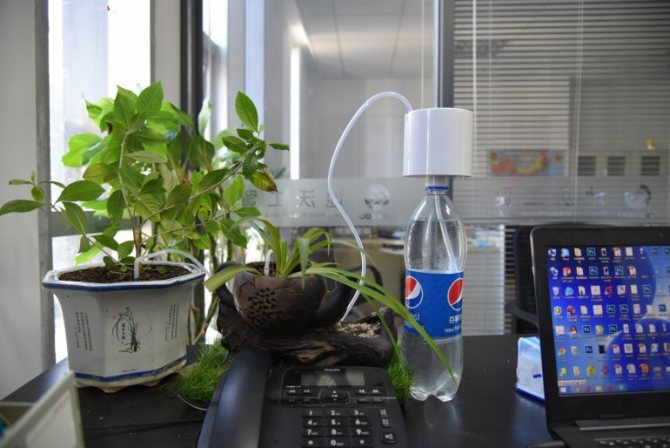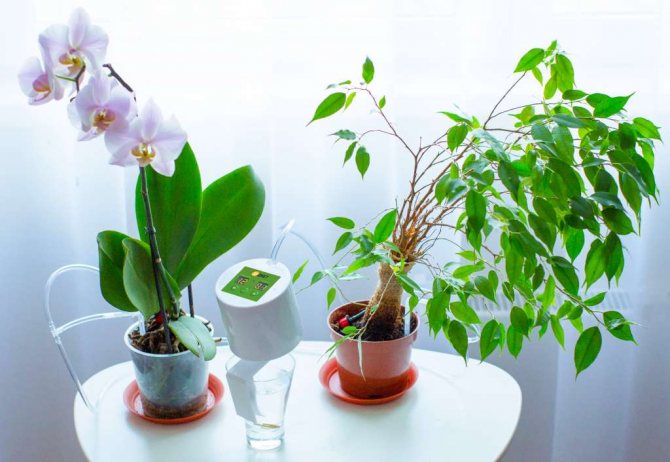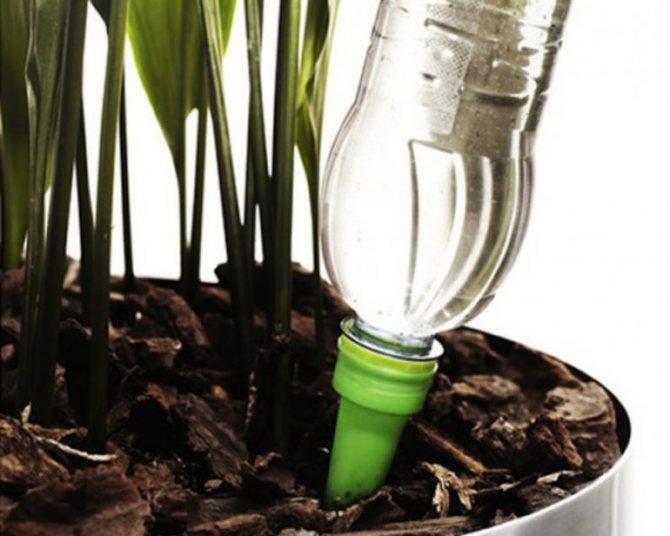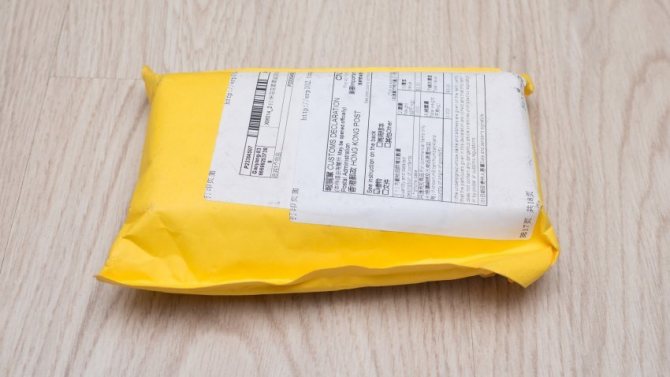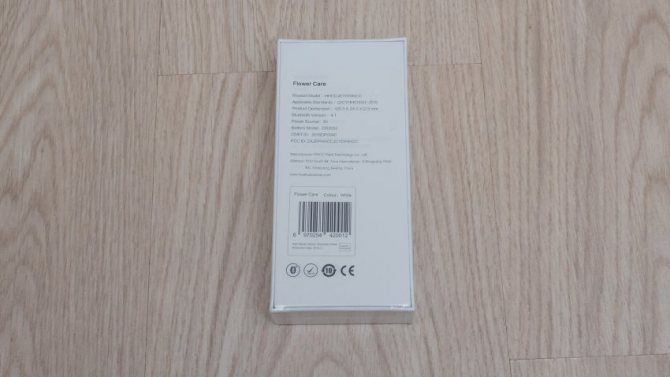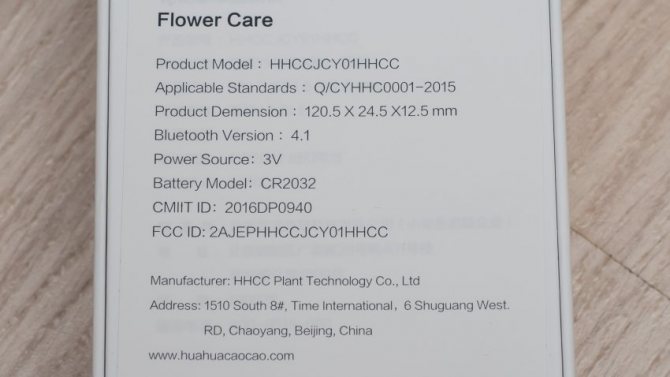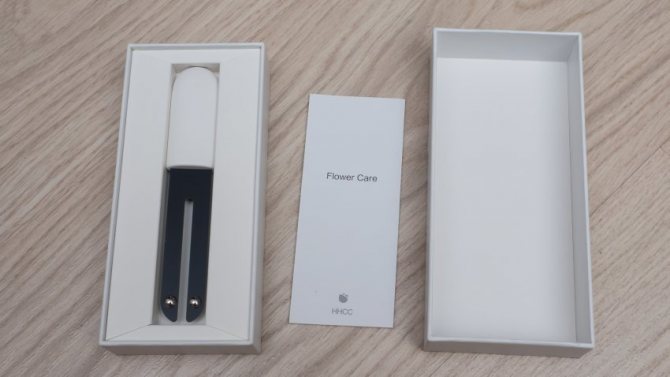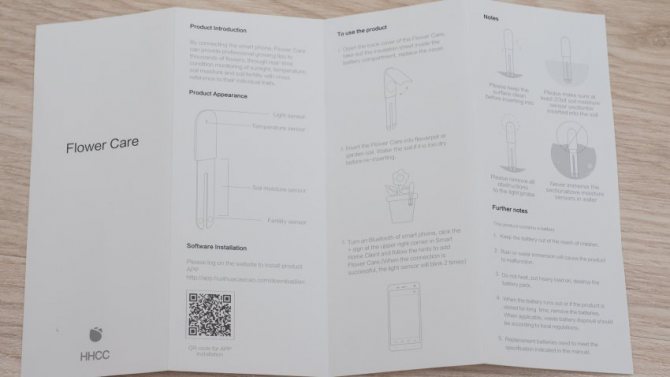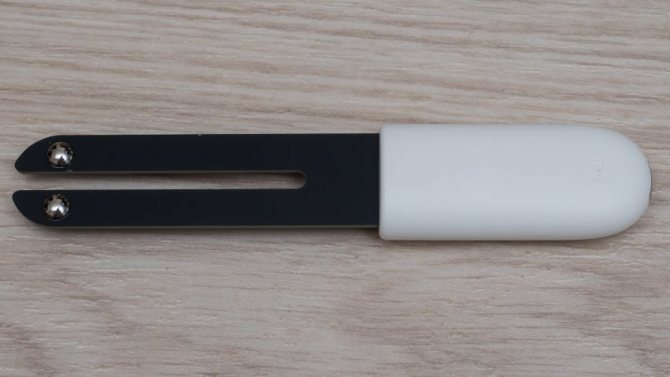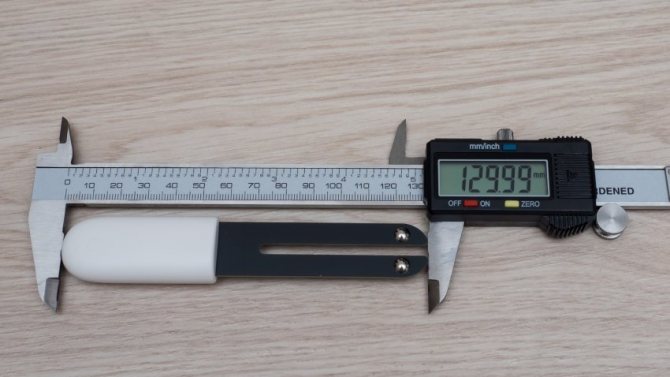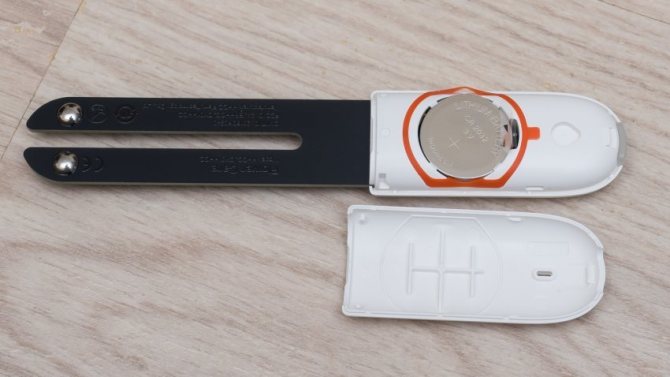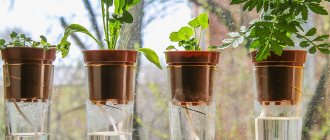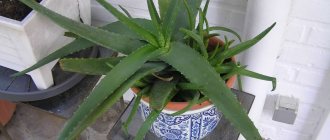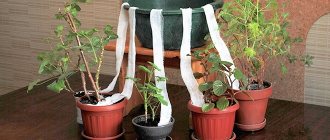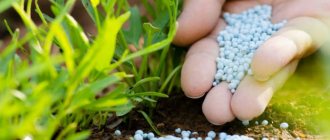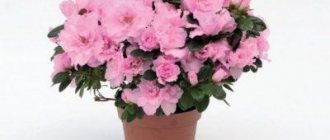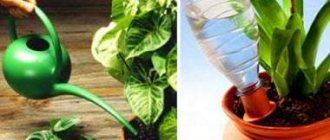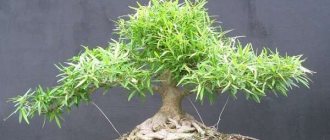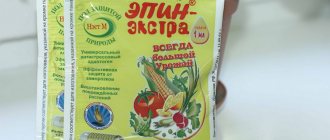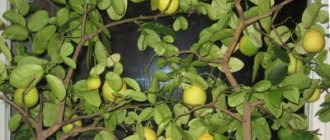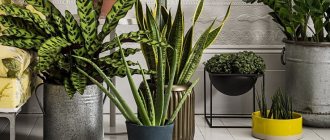Diagram of a simple and miniature block for monitoring the moisture content of the soil of flowers, a simple DIY device with your own hands. Home flowers are an indispensable attribute of any apartment. Some people have whole jungle-like flower gardens at home.
Basically, house flowers, with the exception of some highly exotic plants, do not require careful maintenance - it is enough to water them on time. But, for other more important matters, you can forget about watering flowers, and then they will die. After all, a plant, unlike a pet, cannot urgently demand water from its owner.
But, this task can be solved by electronics. Here is a description of the moisture alarms in flower pots. If the humidity is sufficient, the green LED is on, if you need to water, the red LED flashes.
The alarms are made in the form of small blocks, with two wire probes, with which they are inserted into the ground in a flower pot. All signaling devices are connected by a two-wire cable with one common power supply unit, the so-called "power adapter", which generates any constant voltage in the range from 5 to 12V.
There can be any number of signaling devices. The circuits of all signaling devices are the same. The difference can only be the sensitivity to soil moisture for different plants.
How to retain moisture at the lowest cost
Moisture loss can be minimized — not difficult. It is worth noting that this method should be used only as a last resort, since it has much more disadvantages than positive aspects.
- moisten the earthen lump well by placing the pots in a container of water for a day;
- remove the pots from the windowsills to a shaded place. Everyone knows that the less light a plant receives, the slower it grows and develops. Thanks to this, much less moisture will be consumed. This method has a big drawback, delicate indoor flowers can die without sunlight;
- thin out the plant by cutting off the leaves and inflorescences, so much less water will go away, but after such a pruning, the flower will restore its strength and decorativeness for a very long time;
- make up all the flower pot in a large container at the bottom of which there will be expanded clay flooded with water. For greater efficiency, you can lay damp material or peat in layers between the planters;
- arrange an impromptu greenhouse for the plants, covering them with a film, but with a long stay in this structure, the flowers can become moldy or simply rot. In addition, it will take a lot of effort to adapt the surviving plants to stay outdoors.
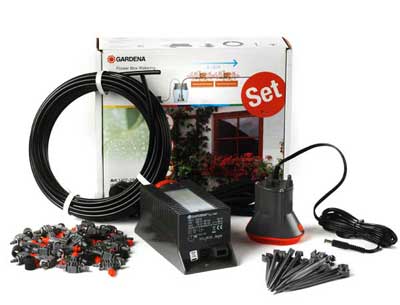
As you can see, the disadvantages are significant
, and if you want to preserve the beauty and decorativeness of indoor flowers, then it is worth considering more gentle methods of retaining moisture.
Plant preparation
If the trip does not come as a surprise, it is better to prepare plants in advance for the upcoming changes.
- Put in the shade so that evaporation is less intense. It also depends on the season, the presence of working heating devices in the room and ventilation.
- Remove affected leaves and inflorescences.Professionals advise to partially thin out healthy leaves, and without fail to remove not only blossoming flowers, but also buds. This may sound harsh, but it will allow the plant to use water more economically.
- Wipe the leaves, sprinkle them with a spray bottle.
- Place all flower pots in one place and cover with foil on top, making several holes in it for air flow. An alternative to the film can be a covering material - it is more porous, promotes air exchange and prevents the formation of mold.
- If you are placing flowers in groups, isolate diseased plants. In the immediate vicinity, even a trivial fungus will quickly infect healthy neighbors.
- All flowers should be well watered just before leaving. In rare cases, the plant is taken out together with the earth (lump) and lowered into the water, but not for long - so that the earth does not crumble.
How to make do-it-yourself drip irrigation
This is a simple and inexpensive method that will allow you to leave the plants for a long time. To build it, you need empty plastic bottles with lids.
Several holes are made in the lid. Pour water into a bottle, screw on the cap and stick the cap down into the ground next to the plant.
The holes must be made in such a way that the water quietly oozes out, and does not pour out in a trickle. The size of the bottle is chosen based on how large the flower needs to be watered and for how long the plants are left unattended.
For a small planter, a half liter bottle will be enough, but for large pots it is better to take a container of 2 liters or more.
Wick system
An easy-to-use and well-known irrigation system that involves the use of a large container of water and homemade wicks. They can be any thread, twine, bandage, laces
... One end is fixed in the pot with a wooden peg, the other is lowered into the water.
If you are often away from home, then you can install the wick during planting by threading it through the hole in the bottom of the pot
... Only in this case should a synthetic cord be used for an improvised wick.
Before starting such an irrigation system, it needs to be tested - water must enter the ground at the right speed. It is easy to adjust, it is enough to correctly set the container with water relative to the planter with plants.
Hydrogel, granular clay, balls
It copes well with automatic watering hydrogel or clay in granules
which can be purchased at flower shops and soaked in water. This material not only perfectly absorbs a large amount of moisture, but also gives it to plants if necessary.
To equip this type of watering you need:
- take a pot slightly larger in volume than the one in which it was;
- pour clay or hydrogel on the bottom;
- carefully pull out the earthen lump with the roots of the flower, trying not to crumble;
- place in a prepared pot;
- fill the void from the sides with hydrogel and cover the soil with plastic wrap.
It is enough to shed the plant well or place the planter in water for a while, and your flower will receive life-giving moisture for a long time.
Droppers
Another effective way to equip automatic watering for indoor plants with your own hands is to use medical droppers. For each pot, 1 dropper is taken.
Manufacturing technology:
- cut off the needles, fasten the droppers to the desired length, hang the load at the ends;
- fill the bucket with water and lower the ends with the weight into them;
- Place the free end in the pot and open the regulator to the desired state.
Important!
You need to choose a method of automatic watering of indoor plants before leaving and test it for performance.
Colorful cones
These original products were invented in our country - water is poured into colored cones, then they are connected to a special leg, which is subsequently stuck into the ground next to the plant.
The advantages of this irrigation method are as follows:
- original and practical solution;
- aesthetic attractive appearance;
- no need to build complex structures.
These are a kind of rugs made of hygroscopic material that can be bought at any flower shop. One edge of this rug is lowered into the water, and flowers are placed on the other.
Advice!
It is better to buy capillary mats complete with pallets - there are 2 of them in one, flowers are installed, and water is poured into the other. Using this method, plants can be left unattended for 2 weeks.
Create a humid environment
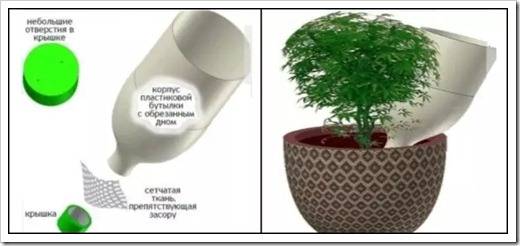

The following are methods that are often used by indoor plant lovers, if there is an inevitable need to leave the apartment for a long time:
- the use of polyethylene hoods;
- use of sphagnum moss and expanded clay;
- use of bottles;
- the use of medical droppers.
The easiest way is to water the plant well and put an ordinary plastic bag on top of it. The downside of this decision is the possible rotting of the leaves (especially when it comes to violets).
In addition, later after arrival, the plants will again have to be accustomed to the air, which will not contain such a large amount of moisture (low percentage of moisture).
The next method is the safest. A little water is poured into the bath. Further, expanded clay is poured into the bath. Then Sfagnum moss is laid on wet expanded clay. Again, all this is spilled with water and flower pots without pallets are placed on the moss (naturally, moss acts only as a conductor of moisture, the water itself should not be higher than expanded clay).
Industrial autowatering systems
If you often have to go on long business trips, then you can purchase an industrial automatic irrigation system for indoor plants.
The most popular Aqua Globs, consisting of a glass bulb and a ceramic cone.
The cone is placed in the ground, and the flask is connected to the water supply using a special hose.
Also known is the Gardena system, consisting of pumps, timer, tubes. By purchasing a similar automatic watering of indoor plants, you can provide moisture up to 36 flowers
.
The simplest drip irrigation
The system described above will be viable longer if provided with moisture source... You can make small holes in the lids of plastic bottles, turn them over and place them between the pots, making sure that the moisture seeps out drop by drop.
Bottles can be stuck directly into the ground. Capacity of each bottle selected individually - 0.5 l is enough for one plant, and for large-sized plants in tubs, you may need several 2-liter bottles.
Read the rules for caring for stephanotis at home in our material.
Why do Calathea leaves dry? You will find the answer to this question in our article.
Despite the simplicity and handicraft of this method, there is production devicesworking on this principle.
They consist of glass flaskconnected to a tank immersed in the ground to distribute moisture evenly.
This is the principle behind the Austrian Blumat irrigation systemsthat can be bought in our stores.
Flower pots with auto-irrigation
This planter has two bottoms between the first and the second there is a water tank. In this case, bottom watering is performed, and the flower absorbs as much moisture as it needs, while the risk of waterlogging of the earthen coma is minimal.
Design advantages:
- the ability to get indoor plants for people who are often away;
- a plant in such a pot does not need careful periodic watering;
- saving time;
- excellent conditions for growing indoor plants, as it regulates moisture consumption by itself.
The automatic watering system built into the pots is very convenient, but it has a drawback: it cannot be used for young plants. The most basic condition for smooth operation is a well-formed and developed root system.
But recently, smart pots have appeared on the market that allow even young plants to be watered automatically.
Cache-pot with automatic watering Coubi
Coubi are inexpensive, practical flower pots that can be purchased as a set, or the autowatering system itself separately
... The pots themselves are made of eco-friendly and high quality material.
The pots are available in different colors, so it is not difficult to choose them for the interior.
Pots with automatic watering lechuza
These are smart German-made self-watering planters that have recently appeared on the market. A distinctive feature of these designs is that the flower will be supplied with moisture for 12 weeks
.
Products are made from durable, environmentally friendly plastic that is not afraid of temperature extremes. For open air, you can purchase special lechuza planters with automatic drainage of excess liquid.
Flower pots with auto-irrigation Green Apple
A modern automatic irrigation system equipped with wheels and a reservoir from which water is supplied.
A special indicator is mounted in the flowerpot, showing the level of water in the container, and with its help the amount of liquid can be adjusted.
The flowerpots are made using modern technologies from high quality polystyrene.
Ikea planter
These pots with an automatic watering system can provide indoor plants with moisture for 2 weeks. These are quality, inexpensive products made from recycled materials.
The flowerpots have different colors, so it's not difficult to choose the right color.
DIY self-watering pot
Due to the fact that it is very expensive to buy pots equipped with an automatic watering system, especially if you need a large number of them, you can independently build a similar system using the materials at hand.
Instructions for making an automatic sprinkler with minimal costs:
- cut a two-liter plastic bottle in half;
- make small cuts - up to 3 cm, on the bottom of the bottle. There should be 8 of them and bend them inward - these are holders for the second half of the bottle;
- take a liter bottle and cut it in half. Make several holes in the bottom and pull synthetic lacing through them;
- plant a houseplant in this makeshift pot;
- place the flower in a pre-prepared water container made from a 2 liter bottle.
Such an automatic watering system is able to provide the plant with moisture for a long time. In addition, you can make a more attractive system by taking two pots of different sizes. Water is poured into a large flowerpot and a smaller planter is installed, in which the flower is located.
In this video, another option for automatic watering:
How to prepare flowerpots for your long absence
- If the plant is unpretentious and "lives" in a large pot, you can just water it well. This may be enough for a week, or even two.
- Do not place the pots on a lighted windowsill or near a hot radiator. So moisture from the soil will evaporate more slowly.
- If there are many pots, put them all in one place. So the plants will create their own microclimate of high humidity, in which they will be as comfortable as possible.
- Cut off all unnecessary - withered flowers (or fresh flowers, as well as buds), old (lower) leaves. So the flower will need less liquid for life.
- Do not feed the flowers for at least 2 weeks before you leave. The fact is that plants need a lot of liquid to assimilate the minerals contained in the fertilizing. And if there are no minerals, there is no waste of water.
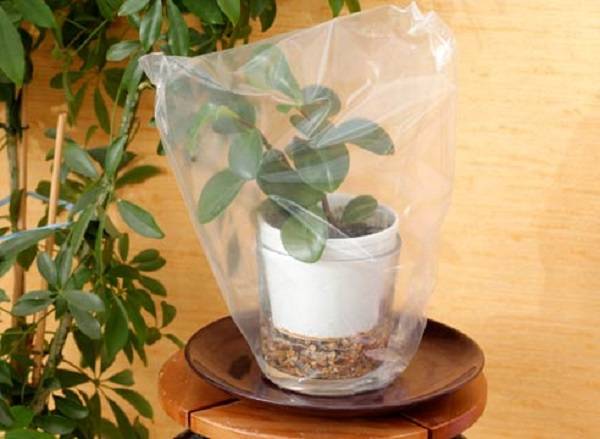

Also, some housewives (owners) wrap the top of the plant with a film or bag so that it loses less liquid.
True, this method is very controversial: for a flower it is a continuous stress, moreover, a plant will not last long in such a close "greenhouse". And if the leaves of the pet have fluff, "under the hood" they may even begin to rot.
Finally, after returning home, it is strictly forbidden to simply rip the bag off the flower: this, again, is stress. First, you need to make a small hole in it, then enlarge it ... In general, the plant needs to be taught to clean air slowly and "from afar", which is inconvenient.
DIY making
The main advantage of the auto-irrigation system for indoor crops is that their root system is able to regularly receive moisture in the required quantities. When you need to make a small greenhouse with your own hands, you can increase the efficiency with an additional source of water, from which plants can receive moisture for many days.
Assembling systems from plastic containers
Assembling a home-made autowatering system for home crops has a number of specific features, but there is also an easier way to make it. To make it, a simple plastic container will be needed, in the lids of which it is worth making small through holes. Then these containers are filled with settled water, turned over and installed between the pots with plants.
Throughout the day, water will flow to the bottom of the pots in small portions, maintaining the optimal moisture content of the layer of bulk material in which the flowerpots are located. But it is necessary to calculate in advance the size of the holes so that moisture can flow in the right amount. But such calculations can only be made empirically. Then it is worth deciding on the volume of the plastic container, which should be enough so that the flowers can receive life-giving moisture for a long time.
When calculating the size of the plastic container, you need to take into account the amount of soil in the pot. For example, when there are very large flowerpots in the room, many containers of water are placed between them. If the greenhouse consists of small flowerpots, then there will be a lot of this number of containers.
DIY drip irrigation from plastic bottles
Pot with automatic watering
Among the many systems used for watering home crops, it is worth highlighting the method in which the plants are connected to a small tank. The flow of moisture to the flowers is carried out using homemade wicks. For their manufacture, you can use various cords, ropes or ordinary threads. And also a wick can be made from a medical bandage, which must be twisted and made to look like a rope.
When the homemade wicks are made, one end is immersed in a container of water, and the other end must be fixed to the planter and fixed in the soil with a small peg or an ordinary clothespin. This design provides a pressure difference in the capillaries, because of which moisture will move through homemade wicks from the container to the pots. An automatic watering system for home flowers, which is based on the use of homemade wicks, is capable of achieving a high-quality supply of moisture to crops at the lowest cost and effort.
Purchased automatic irrigation
In order to facilitate the process of creating optimal conditions for home plants, you can use special tools that are sold in gardening stores.
Hydrogel or granular clay
The original polymer absorbs a large amount of moisture - a ball weighing 2 g holds from 200 to 500 ml of water. When it gets into dry ground, it begins to give away what is stored.
There is a hydrogel for indoor plants in the form of transparent or matte colored granules. Recently, hydrogel capsules have been developed that contain special fertilizers to provide the green pet with nutrients.
Important: according to the manufacturer, with regular use, the hydrogel beads last for 4 years.
Application options:
- If you plant a plant in soil with dry granules and water it well, the material will absorb excess moisture, and then slowly give it back.
- You can place the ball in a small hole in a flowerpot with an already growing flower and water it. The process will be launched instantly. Therefore, the procedure should be carried out just before departure.
- Soak the capsule for 7-8 hours before leaving, and then pour the granules on top of the soil mixture, cover with moss.
The cost of a package depends on the number of balls in it - from 1 to 20 dollars. Granular clay is made from natural ingredients, but operates on a similar principle.
Important: if you put a lot of saturated elements in a container with a small amount of earth, there is a high probability that the plant will rot.
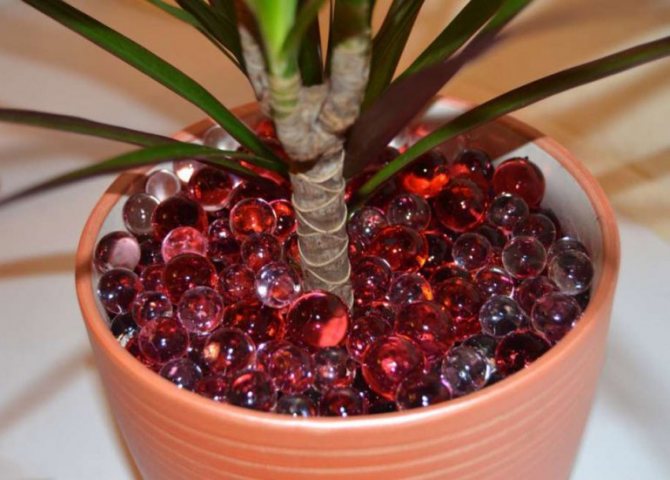

Capillary mats
Perfectly provide automatic watering of home flowers and future seedlings. The device is made of a substance that is capable of transferring liquid by the method of capillary pressure: the mat is spread on a horizontal surface, and pots with a drained bottom are placed on it.
One end of the "mat" must be in constant contact with the liquid. For this, a bowl placed one level below is suitable.
Such self-watering for flowers with your own hands has a big plus - many plants are placed on one rug. Significant disadvantages include the high probability of decay of roots, which are constantly in a humid environment.
This option is completely unsuitable for such finicky flowers as cyclamen, or for representatives of the orchid family - the plant will die. Bulbous plants will also not be able to receive liquid due to the fact that moisture reaches the lower roots, which they do not have.
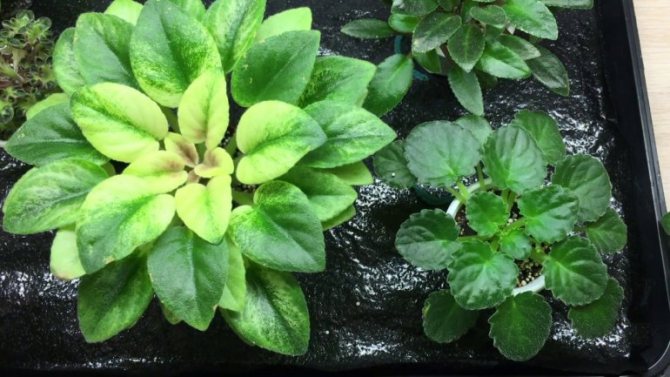

Micro-droplet system
It is often used for organizing home watering, although it belongs to industrial ones. There are several options.
They differ in the type of food, the method of intake and supply of water, the number of plants served. Some expensive installations have timers and displays with fine tuning of work, so that you can water your home greenhouse completely automatically.
Popular are multifunctional models with regulation of the intensity of soil moisture. The cost depends on the capabilities of the system and the country of the manufacturer.


Ceramic cone
Uncomplicated device with simple operation. More suitable for compact plants. Sold with or without a container, but with a universal thread for mounting.
The porous ceramic material gradually moisturizes the soil, preventing it from drying out and ruining the flower. Installed closer to the side of the pot and away from the rhizome, so that it does not rot.
Functional pots
The option is relevant for those who like to see live plants in their home, but who do not have the opportunity to pay enough attention to them.
The system, unique in its kind, works on the principle of communicating vessels: in one water, and in the second a plant. All that is required from the owner of such a device is to add liquid to a special connector on time.


With the help of a pots with an automatic watering function, it will be possible to achieve an ideal environment for ferns, capricious orchids, cacti that do not like moisture and other indoor plants. The advantages include: protection of roots from decay, an aesthetically pleasing appearance, the ability to not worry about the health of the plant for a long period.
Before finally deciding on a specific system, it is recommended to check its functionality on one, the most picky plant. Let the flowers delight you with delightful colors, bright green foliage, clean air in the house and a healthy long period of life.
Factory devices
When a person has the financial ability, it is possible to provide home crops with moisture by installing a factory automatic irrigation system. Experts distinguish these types of them:
Impulse and fan sprayers of water for the garden
Capillary mats
To solve the problem of providing home crops with moisture, special capillary mats can be used. They are small rugs made of hygroscopic material. Such devices can be purchased in specialized stores at a fairly low price.
The capillary mats can be laid on any kind of surface, for example, on a windowsill or a large table. But for effective use, part of it must be immersed in a container with water. Before laying such a product, it is necessary to cover the surface with a film, otherwise small drops of water can damage the window sill lining.
Quite often, the dimensions of the capillary mat do not allow lowering its edge into a container with water. Then specialized strips can help, which must be abundantly moistened with water, and then one end must be placed under the product, and the other must be immersed in a container. The principle of operation of such strips is very similar to using wicks, which are made by hand and provide moisture to the pots.
Special pallets
To assemble an automatic irrigation system for home crops, you can use specialized pallets that work on the same principle as capillary mats.
The design of a special pallet consists of the following elements:
- deep pallet proper;
- a small additional pallet;
- capillary mat.
A deep pan is used to store water, and a smaller pan is placed in it, at the bottom of which there is a capillary mat. Then a pot with a plant is installed on it. For many days, through the capillary mat, water will flow to the pots with home crops. The advantage of this method of organizing the automatic watering system is that it helps to avoid rotting of the root system of flowers.
Going on vacation? Automatic watering for indoor plants is a great way to take care of them without bothering strangers (and without worrying that they might forget about the request). Automatic watering is also popular among the owners of large collections of flowers: it can be difficult to water them manually every time. Finally, the auto-irrigation system for indoor plants is useful both at home for very busy people and in offices, especially when there is no constant “in charge” for flowers. In this material, we will consider different types of automatic watering and figure out how to make this or that device.
Irrigation of flowers with drops is a fairly simple and reliable way of watering in the absence of the owners. A regular plastic bottle is suitable for this. You need to make small holes in its lid, then fill the bottle with water, attach a mesh to the neck (so that the water does not flow out too quickly) and tighten the lid. The bottle can then be stuck directly into the soil or placed in a pot with the lid down. The volume of the bottle should be directly proportional to the size of the flower pot. The bottom of the bottle can be trimmed to create a funnel. Some automated watering machines work according to this principle.
Automatic watering for indoor flowers
For indoor plants, a period of two weeks without watering is not considered critical. To increase the chances of flowers for survival, you need to remove them from the windowsills, arrange them together and put them in the shade, placing reservoirs of water next to them to increase the humidity.If you have decent financial capabilities, you can organize automatic watering of flowers at home using ready-made systems. There are also inexpensive devices - simple polyethylene droppers, cones, self-irrigating pots, or capillary mats.
Auto irrigation - advantages
Indoor automatic irrigation systems have significant advantages over other options:
- Provides uniform watering of plants over a long period of time.
- Moisture is gradually supplied to the plants in the required amount.
- The systems are simple to use, watering is often done and there is no need to constantly monitor the process. Human participation in such manipulations is minimal.
How does auto-irrigation of indoor plants work?
You can organize automatic watering for indoor plants using various ready-made devices:
- Self-irrigating pots.
The vessel consists of two parts; a drainage substrate is used as an interlayer. The upper part is for planting flowers, the lower one is a water tank. In order for the flower to receive moisture, special ropes are inserted into the pot. The advantage of the device is an indicator showing the remaining volume of water. - Enema balls.
Ball-shaped flasks made of glass or plastic with a watering pipette are filled with water and inserted into the ground. When the soil dries up, oxygen enters the leg of the enema and pushes the water droplets out. - Ceramic cones.
These are kind of "carrots" with holes that are inserted into the ground. Plastic tubes extend from the cones into a reservoir of water. Moisture is drawn from the vessel under pressure as the soil dries out. For large plants, it is recommended to use several of these tools at the same time. - Capillary mats.
They are mats made of hygroscopic material. The mat is spread on a flat surface, one of its edges is lowered into a vessel with water. Vases with flowers without pallets are placed on it. The rug will draw water from the container and give it to the plants. So the flowers will be able to survive up to 3 weeks of the absence of the owners and their roots are guaranteed not to rot. - Ready-made systems for micro-drip irrigation.
The device for automatic irrigation of plants is presented in the form of a large container with water and tubes equipped with tips that are inserted into the ground. The drippers can be adjusted with a special wheel, with which the irrigation intensity is set. There are devices that are connected to the central water supply system, equipped with a timer, pump and program control. They irrigate periodically at set intervals.
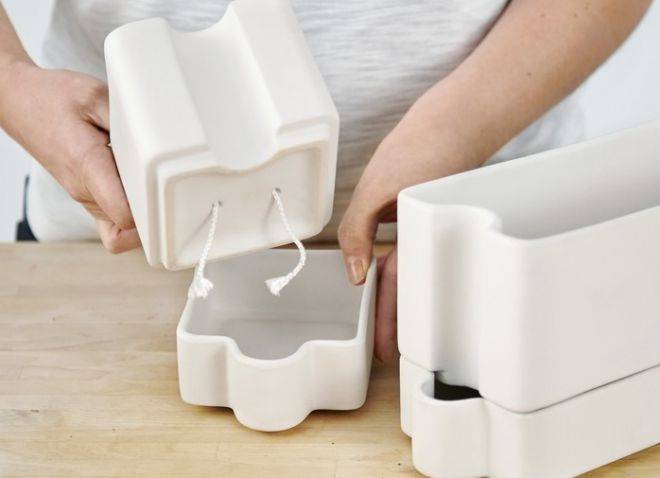

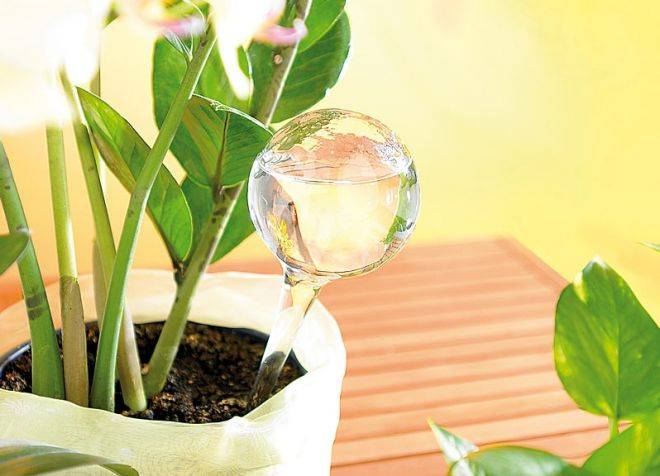

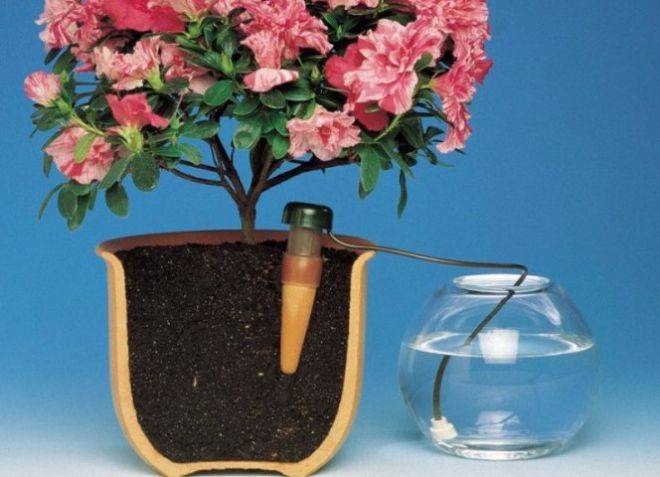

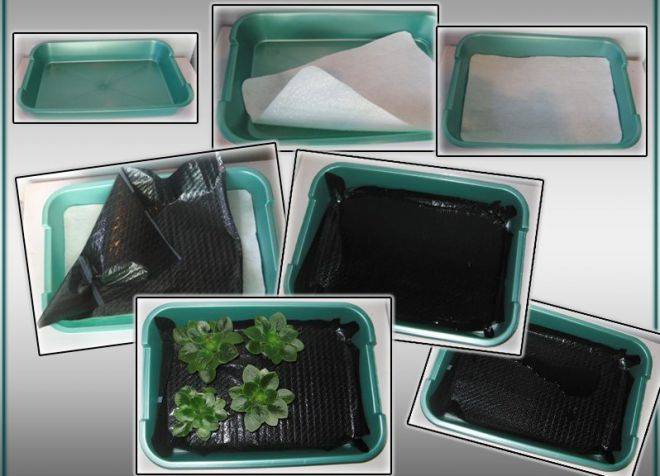

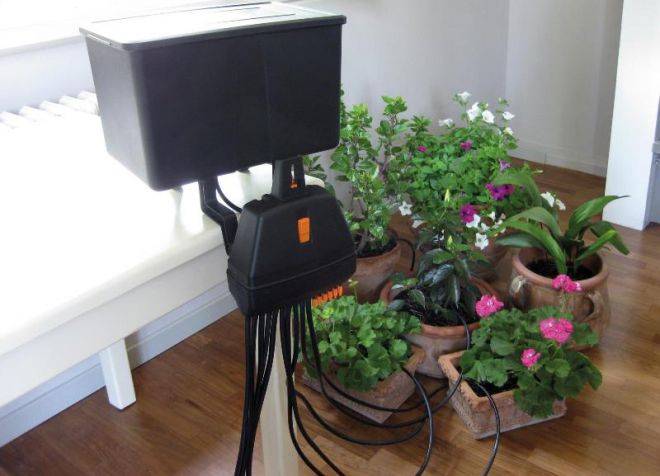

Wick system
Simple self-watering of plants with your own hands consists in creating "wicks", that is, cords, one end immersed in flower pots
, others - in a container with water.
Moreover, the cord can be either attached to the soil surface (using a peg or hairpin), or placed in a pot in advance by passing it through a hole in the bottom when planting a plant. The "bottom" method is good for flowers that require a light substrate, such as violets. It is often used by breeders of these home flowers. These cords can be supplied to the pots in advance, if the owners periodically leave for a long time.
Please note that you will still need it if you periodically water the plant in the usual way, but if you intend to use only the bottom wick watering, drainage is not needed. For this, only synthetic cords are suitable, since ropes made from natural materials will quickly begin to rot and break. Such a system requires "tuning": the higher the container with water is located relative to the pot, the faster the moisture will seep out. In this way, you can pre-adjust the appropriate watering intensity for a particular plant.
Features of installation and use of wick irrigation
It is much safer to use active autowatering techniques, one of which is the wick system. You can easily assemble it with your own hands, you just need to perform the following manipulations:
- We take a container of impressive size, fill it with water, set it up so that pots with green spaces can be placed around.
- Cut a long cord made of fabric fibers into pieces. We lower one end of each element into the water, the other - we bury the flower in the ground.
- If the manipulation is carried out at the stage of transplanting indoor plants, then it is better to pass the cord through the holes in the bottom of the pot.
- After the preparatory stage, you need to moisten the earthen ball and make sure that the wick is also soaking through and through and delivers moisture.
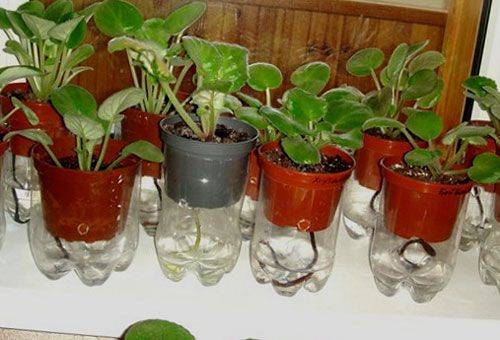

Contrary to popular belief, the system is positioned in such a way that the recharge is carried out from the bottom up, and not vice versa. Otherwise, the moisture will be too active and can provoke rotting of the roots. The effectiveness of a hand-made device and the duration of its action depend on the needs and dimensions of the sample.
Hydrogel and granular clay
Watering indoor flowers while on holiday can be done with hydrogel or special granular clay, which can be easily found in flower shops.
They quickly absorb moisture and then gradually give it to the plant. Pick up a large enough pot, cover it with a layer of hydrogel or clay, then place the plant on top. At the same time, the roots of domestic plants should remain in an earthen coma, as during transshipment.
Then fill the remaining space between the ground and the walls of the pot with the rest of the product and cover its surface with polyethylene. This method can be used for a relatively long period, especially since it is often not worth tormenting the plant with transplants. If necessary - if the hydrogel or clay begins to dry out - you can add water to the pot.
Varieties
In order for the plant not to die, it needs water. In our case, we need a source from where it will evenly, but in the right amount, enter the flower pot. Since this problem is not new, there are all sorts of gadgets commercially available. But in the confusion, you can forget about them, and it's not difficult to do something like this yourself.
From the bottle
The first option requires a bottle. Ideally, plastic, but you can take any. The main thing is that it has a lid. Wine bottles framed by greenery look more aesthetically pleasing. They can also be painted, decorated using decoupage technique or decorated with ribbons, rhinestones, beads. This option will come in handy even with regular maintenance, for example, it will make it easier to endure the heat in summer.
Manufacturing instructions.
- It is easier to pour water if the bottle has no bottom. But you can pour it through the neck.
- We make one or two narrow holes in the cork so that the water drips. We close and install in the right place.
- You can simply put it down or stick it with its neck into the ground. Then you can judge the intensity of irrigation by the amount of decreasing water. The bottle can be hung over the flower, but not high.
Watering is regulated by the width and the number of holes in the plug. If it comes into contact with the ground, you need to put a piece of any mesh fabric under the cork and twist it so that its ends look out with a margin. It will prevent dirt from entering the inside of the bottle.
With rope
This structure requires a cord, twine or any other rope. In the absence of such, strips of fabric twisted into bundles can be used. In this case, the rope should absorb water well. It is believed that synthetic fabrics are preferable to natural ones, as the latter can begin to rot. But for a week and with naturals nothing will happen.
The principle of operation of the structure.
- One side of the rope is lowered into a bowl of water, the other is placed in a pot.
- You can position the rope both from above - so that the free end lies on the ground, and from below, pushing it into the hole for water drain. In the latter option, more water will be retained in the soil, since it will evaporate less. But there is a risk that the rope will be pinched by the pallet and there will be no inflow.
If the container with water is wide (for example, a basin), the water will actively evaporate and maintain the necessary humidity in the room for the comfortable state of the plant.
From one basin, you can lead the ropes to different plants. Or, if the flower needs a lot of moisture, put several sources of water with strings on different sides. To prevent the rope or harness from sliding from the designated place, they must be fixed.
With hydrogel
The automatic intake of moisture can be achieved with the help of various substances capable of absorbing water. After it evaporates, they usually dry out. The most popular are hydrogel beads. Even cut flowers can stay fresh in them for a long time. And some plants are planted in them as in the ground. The hydrogel is quite capable of temporarily replacing watering. This requires:
- hydrogel balls;
- a larger pot;
- water;
- plant.
Progress.
- Soak the balls in water to swell.
- Remove the plant and soil from the pot. To do this carefully, without damaging the roots, the soil in the pot must be moistened.
- Fill the bottom of the larger pot with balls. Then we put the removed plant with the ground in the center. Balls should fill all the remaining space around the circumference of the pot. They are also placed on top with a thin layer.
Recommended: Grow a cactus? Easily!
Drying, the balls will give water to the soil. To slow down this process, you can additionally use any other autowatering method. There are rugs with similar properties - flower pots are placed on them. Cut into thin strips, they absorb water well, so they can be used instead of ropes or rags.
On pallet
The easiest way to auto-irrigate is to place all the pots in a tray or tub of water. But, despite the simplicity, there are drawbacks here:
- moisture will only enter the lower layers of the soil, which is not suitable for plants with a weak root system;
- if you do not change the water for several days, it will turn into an ideal breeding ground for mold or mildew;
- in the lower part of the soil, water may stagnate and there will be no outflow.
It is much safer to put everything on a base of expanded clay, filled with water.
About the same principle, pots with automatic watering work. A cache-pot is a decorative container in which the pot itself is placed. In addition to the fact that it serves as a kind of decoration, it is into it that water flows from the drainage holes. The essence of autowatering is simple - water is poured into the pots, which feeds the plant through the same holes. In purchased models, a special float is built into the planter, which shows the amount of water. At home, the water level will need to be checked independently at regular intervals.
And the volume of water that needs to be poured can be calculated empirically and make the appropriate mark on the inside. The pots, of course, need to be washed at least once a week.
With dropper
Droppers can also participate in the water supply. No needles are needed, just a water container, straws and a flow regulator. Advantages of the system:
- transparent material looks unobtrusive;
- the tubes can be joined to the required length;
- you can easily adjust the amount of incoming fluid.
In order for the flow to be constant, it is important to correctly position the end of the hose and the container of water. The container should be above the level of the pot, with the hose at a slight angle. Its length is easy to cut. To prevent the hose from moving, it is loosely tied to a plastic or wooden peg.
From tubes from droppers and hoses that are suitable in diameter, but borrowed from other areas of hoses, you can create whole systems for watering several indoor plants at once.
But even here it is important to monitor the position of the entire structure so that the water flows evenly and the tubes do not bend. It is also important to take care of the tightness of the joints.
Droppers
You can do autowatering from a medical dropper. You will need one for each pot. Blow-test all tubes, then secure them together without pinching and attach to the weight to prevent them from floating. Then, as in the wick system, one end of each dropper must be placed in a flower pot, and the other in a container of water of the appropriate volume. It must be placed above the pots, for example, in. Finally, open the droppers by setting the slow setting. By the way, you can create and configure a flower pot with auto-irrigation using the arduino controller: such a "smart pot" can include a dispenser, soil moisture control, a water level indicator in a container, etc.
A rduino is quite easy to use and provides many opportunities for flower care, not only during the absence of the owners, but also in everyday life. In order to design an autowatering device using arduino, you can often do without even programming and circuitry skills: there are a lot of detailed tutorials on the network that describe everything from the first step. In many cases, even soldering can be dispensed with. Gadgets made with arduino can make life much easier for a flower lover or someone who is engaged in their professional cultivation.
Homemade watering system for multiple indoor plants
You will need:
- plastic container of at least 5 liters (for example, a bottle for a cooler);
- medical droppers, for each pot - separate;
- soft wire;
- weight (to prevent the ends of the droppers from floating);
- container support (chair, stool, etc.).
Procedure:
- We fill the container with water.
- We carefully tie the ends of the tubes with a wire into a bundle, without pinching the tubes.
- We attach a weight to the wire.
- We install the container on the stand.
- We lower the connected ends of the tubes together with the weight into the container.
- Fully open the regulator on one of the tubes and suck in water with your mouth. After the water has flowed, close the regulator completely.
- Carefully insert this end of the tube (so that the tube does not get clogged) into the soil.
- Open the water supply regulator on the tube a little.
- We carry out the same steps with the rest of the tubes.
It is necessary to monitor the system for some time and adjust the amount of water flow.
Cones
You can purchase the simplest and at the same time bright and original sprinkler - a cone on a leg. They come in different shapes: in the form of balls, birds, snails, etc., they can be transparent or decorated with bright prints. Usually made of plastic.
The irrigation system is simple. Before leaving, you fill the flask with water and stick the leg into the ground. When the earth begins to dry out, oxygen enters the leg and pushes out water, which moisturizes the earth. Thus, water is poured in only as the soil dries up, without flooding it. My feet flower growers also fell in love with such a watering pad because it serves as an excellent interior.
Convenient drip irrigation from a plastic bottle
Another convenient and safe method of autowatering is the use of a drip design. In this case, water will not be supplied to the soil constantly, but with a certain frequency. The most difficult moment is precisely the determination of the fluid flow rate and the debugging of the process.
- We make a deep funnel from a plastic bottle, cutting off the bottom. We make several holes in the lid of the container. We pass the neck of the bottle through the net and screw the lid on.
- The drip irrigation system is installed above the pot, fixed and filled with water, providing a supply of liquid to the soil surface.
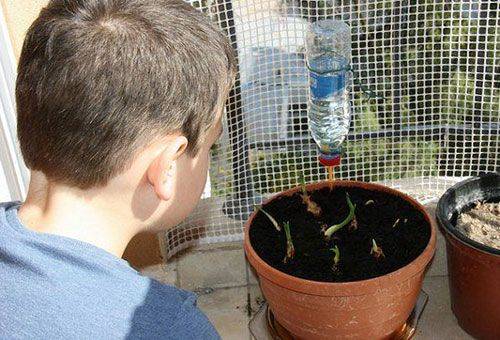

This attachment is best used to feed large indoor plants such as monstera or ficus. For more delicate samples, it is best to use the most common medical dropper. The container with the liquid is installed on a tripod, and from the end of the outlet tube, water droplets fall onto the soil. It is only necessary to fix all the elements with high quality and adjust the rate of moisture supply.
In addition, drip irrigation can be represented by special flasks produced in different sizes. You don't even have to strain too hard. Simply fill the flask with water and insert the discharge tube into the soil. As the earth dries up, air will penetrate into the container, releasing just as much moisture as needed. With such a system, you can safely leave the pots with plants even for a long time, the main thing is to correctly calculate the volume of the container.
Capillary mats
Automatic watering of your indoor plants can be carried out using a special rug made of materials with high hygroscopicity. Flowers in pots with a bottom hole are placed on such a rug, after which one end of it is immersed in water. It is convenient when two pallets are included with the rugs. Water is poured into the large (external) one, then a small one with holes at the bottom is placed in it.
A rug is lined on top and flowers are already placed on it. Thus, a self-made or store-bought auto-irrigation system for indoor plants will help your green pets easily survive your absence for several days or longer. As you can see, there can be a lot of options - from a simple sprinkler cone to a smart pot created with the help of a rduino.
Plant preparation
Prepare your plants properly before setting up automatic watering. For indoor flowers to have enough autowatering:
- Try to reduce the amount of evaporation from the soil. To do this, place the pots in a dark place. The less light falls on the leaves and stems, the slower the plant will develop, and, therefore, consume moisture.
- Check in advance if the plants have pests or diseases, and, if necessary, treat the flower.
- Do not feed the soil at least 2 weeks before departure.
- Remove dried flowers, leaves and buds. So the plant will spend less energy and nutrients.
- To maintain maximum moisture around the flowers, place the pots as close to each other as possible or place them in a bulk container with moistened expanded clay.
- Water the soil generously before leaving. You can also use the method of immersing the earthen ball in water, depending on the variety.
- For compact species, you can organize a greenhouse by covering the pot with a plastic bag or bottle.
If you often leave the apartment for a long time, it is worth replanting the flowers in clay pots. In such containers, moisture will be retained longer.
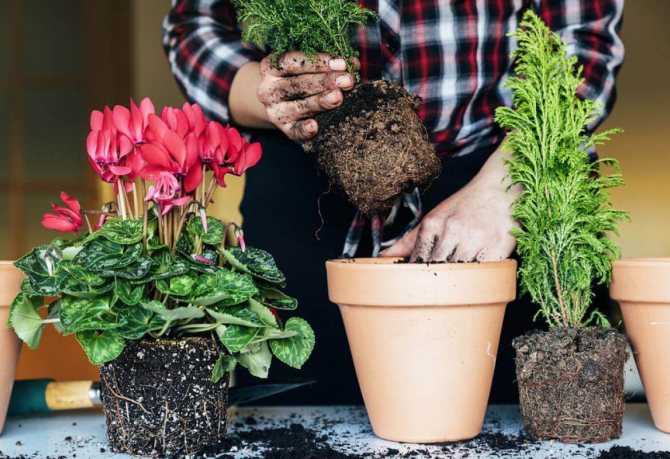

What not to do
The only and main mistake of a florist when going on vacation is to fill the plants up to capacity, hoping that this volume of water will be enough for them all the time. As a result, root rot often develops. Or the soil simply dries out to a stone state. Reanimating such plants is very difficult, sometimes impossible.
If you ask relatives and friends for a service, be sure to leave them detailed instructions - what, when and how much to water. For those with no experience in floriculture, with the best of intentions, the more water, the better for the plants.
Secrets of maintaining moisture without using automatic watering
Leaving your home for a short time, do not immediately panic and start designing complex automatic watering for 3-5 flowers.You can try to solve the problem quickly at no cost.
Attention! It should be noted right away that this method has many disadvantages, and it may not be suitable for capricious plants, especially those who do not like high humidity.
The essence of the method under consideration consists in a number of procedures aimed at maximizing moisture conservation in the soil. What should be done:
- First of all, indoor flowers are flooded with water. If the plant is easily removed from the pot with a clod of earth, then its root system is immersed in water for a short time. As soon as the soil lump begins to soak, the flower is immediately returned to its place in the pot.
- After water procedures, all plants are removed from the windowsill. They need to be placed in a semi-dark place. Here you need to be prepared that with the limitation of lighting, plant growth will slow down, but evaporation and absorption of moisture by the plant will significantly decrease.
- The decorative effect of the flowers will suffer from the next action, and they will then recover for a long time, but this procedure cannot be dispensed with. If flowers have opened on the plant or buds have appeared, then they need to be cut off. If possible, it is advisable to thin out the dense green mass.
- Plants that have passed all stages of rigorous preparation, together with the pots, are placed in a deep pallet, at the bottom of which a 50 mm layer of expanded clay is poured. Next, water is poured into the sump so that it covers the stone filler.
- The last step is to create a greenhouse. The plants displayed in the pallet are covered with a thin transparent film.
When the owners return home, the flowers will need to be re-accustomed to indoor air. To do this, the film is gradually opened until complete adaptation of the plants occurs.
Attention! Indoor plants with a fringe on the leaves from excess moisture under the film will begin to become moldy. Over time, rot will appear, and the flowers will die.
Drip technology application
If necessary, you can equip a gradual irrigation system for indoor vegetation. The design in question is effective, since it correctly determines the intensity of the flow of water into the flowerpot. Several variants of such systems can be created at once. Unique drip irrigation for indoor plants has its own design features.
To create drip irrigation for large plants, you need a plastic bottle. It is necessary to make a funnel out of it, and punch holes in the lid. You will need a net that needs to be wound around the neck of the bottle. Next, close the wrapped bottle with a lid. It should be fastened with the cover down. Such drip irrigation of indoor plants is easy to arrange. For plants that grow in large containers, drip irrigation is the best solution.
However, such automatic watering of indoor plants is not suitable for flowers growing in small flowerpots. In this case, it is better to use river sand. We put it in a deep container, then place the flower pots in it only halfway. All containers must have sandbox drainage holes. A plastic drinking bowl is attached in the center above the sandbox. Moisture is evenly absorbed by the sand, which, in turn, feeds the plants.
Characteristics of the pots
Lechuza planters are available to consumers in various sizes, colors and shapes. The combination of excellent performance and presentable appearance makes it possible to decorate an office or living space with them, without the risk of disrupting the harmony of the interior style.
Consider the main technical and operational characteristics of the pots:
- UV resistant.
- Light weight, which greatly simplifies transportation.
- Impact resistance. The product is made of durable plastic, however, the surface is susceptible to sharp objects, it is easily scratched.
- Resistant to temperature fluctuations.However, it is not recommended to use the product outdoors during frost periods, as the water in the tank will turn into ice, which in turn will lead to the death of the plant.
The lechuza planter is a gentle care for green pets, and in more detail how this system works, you can see in this video.
Which flowers tolerate drought more easily?
Before you set up automatic watering for plants, it is worth learning how different varieties and species cope with drought. On average, this interval is from 7 to 20 days. It is very difficult to predict how indoor flowers will behave during a drought, since the frequency of watering must correspond not only to the plant variety, but also to the season and temperature in the room.
You can find approximate information about these periods in the table.
| Type of plant | The number of days that the plant calmly survives without watering according to the season | |
| Winter | Summer | |
| Cacti and some succulents | up to 30 days (resting phase) | up to 14 days (growth phase) |
| With leathery leaves | Up to 14 days | up to 7 days |
| With thin leaves | up to 10 days | up to 5 days |
| Tuberous and bulbous | up to 7 days in the growth phase |
If you are in no doubt that you will return home within a period that will not exceed the recommended time, do not worry. Otherwise, take care of the organization of automatic watering.
Advantages and disadvantages
Flower pots with an auto-irrigation system have both fans and enemies. Basically, such pots are necessary for those people who often go on long trips. Holidays, business trips, long-term treatment or a visit to relatives in another region, another country are often forced to leave an apartment unattended. Not everyone has someone to entrust the care of plants at this time. And it is not always convenient for the owners. If you use a pots with automatic watering, you can safely leave for at least a month, without causing problems to anyone.
Self-irrigating pots
The self-irrigating pot consists of two containers. A plant is planted in one of them, water is poured into the other. The plant gradually absorbs moisture through special wicks.
ON THE PICTURE:
"Smart" containers cope with the function of automatic watering of plants. Photo Tatura Florist
.
Such a container is usually equipped with a water indicator. This allows you to accurately determine how much moisture is left in the pot and when to top up. The technology of self-adjustment of such an irrigation system is shown in the video: "".
Sprinkler with intermittent water supply
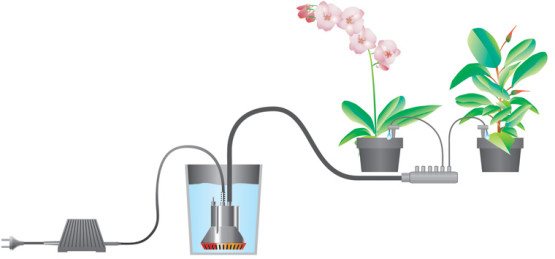

Such a system is somewhat more complicated than the previous ones. For assembly you will need:
- water tank;
- small pump;
- power supply, voltage depends on the selected pump;
- timer with power-on function;
- two pipes for water supply.
Such a sprinkler is assembled as follows. The pump is connected to the power source through a timer, after which you need to connect the pump and the container with one tube, and immerse the other in the ground. Thus, the timer will turn on the pump at the time you set.
The advantage of this system is that the plants will be watered at a predetermined frequency during the vacation. Such a watering device is perfect for indoor flowers that cannot tolerate excess moisture. The disadvantage of such a device is the complexity of the assembly and the relative high cost.
Simple solution to the problem
If long absences are not a system and the problem of watering in the absence of the owner arises infrequently, you can resort to the most budget-friendly way to preserve moisture in indoor plants. For this you will need:
- Moisten the potting soil abundantly.
- Remove plants from sunny areas and move them to a shaded area. This measure will reduce moisture evaporation. It should be noted that the proposed method is not suitable for all indoor pets.If certain species simply slow down their development, then the state of light-loving plants can deteriorate significantly.
- Preliminary removal of buds, blossoming flowers and dried foliage will help to reduce moisture consumption.
- The pots are collected in a large container - a basin, trough or bath. The bottom of the container is 5 cm covered with a layer of expanded clay, after which it is poured with water. If possible, wet pieces of sphagnum are distributed between the pots with indoor plants. The entire set is covered with foil.
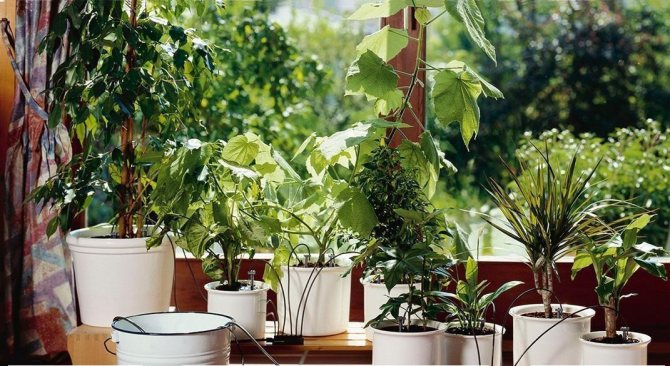

Comment! Greenhouse conditions are not suitable for houseplants with pubescent leaves, which will rot if there is a lack of fresh air flow.
Upon arrival home, you should gradually return the flowers to their usual conditions and accustom them to open space. The proposed auto-irrigation option has a lot of disadvantages, so it is better to resort to improved systems for automatic watering of indoor plants, which are easy to build with your own hands or install ready-made structures.
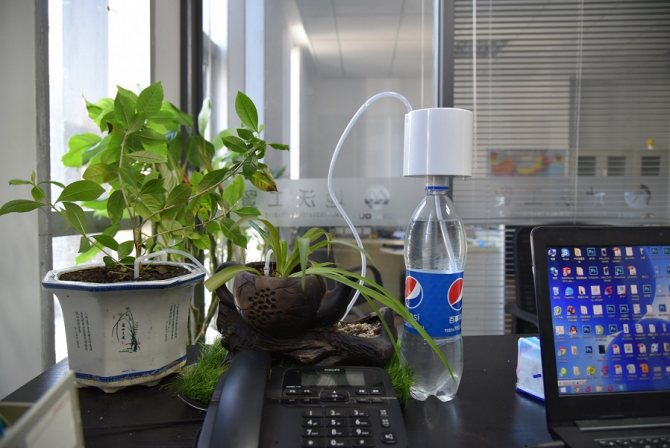

Let's sum up
The drip irrigation system is one of the most efficient. When using it, a crust does not form on the surface, the roots are not injured or washed out. The plant constantly receives moisture in small portions, which is ideal watering. That is why such a system gives the best results, contributing to the ideal growth and development of a green pet. There are automated systems that are expensive, and medical droppers allow you to create an exact copy of them yourself almost free of charge.
Care of system elements
The container itself, pipes and hoses can last for years, but fragile droppers need regular cleaning. If they are not regularly removed and rinsed, they will clog up with impurities in the water. In order to extend their life and increase the periods between cleanings, a filter can be installed in front of the supply line. This measure is also good for delicate indoor plants, the roots of which also suffer from impurities in the water. This is how automatic drip irrigation works from drippers. There can be as many home flowers as you want, such a system will cope with watering completely autonomously. All you have to do is enjoy the luxurious home garden.
Alternative option
If you often leave home, but want your plants to always feel good, you can try implementing a watering system using plastic bottles. She works equally well in the garden and at home. The essence of the method is as follows: a plastic bottle, in which several punctures are made, are buried in the soil (garden bed or large pot). Only a neck with a cork remains on the surface, through which it is filled with water. For about 4 days, such a bottle is capable of feeding 3-4 tomato bushes. With regard to indoor plants, this method is only suitable for large flowerpots.
Shoelace sprinkler
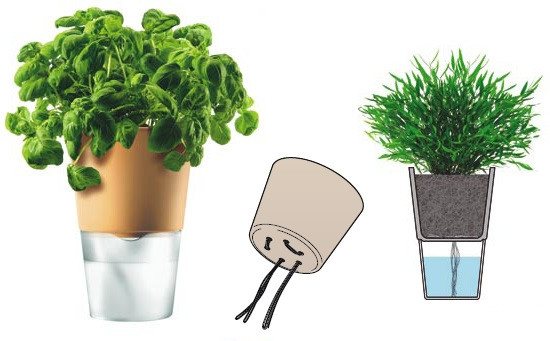

Automatic watering of flowers in pots, made by means of laces, works on the basis of the difference in capillary pressure. For manufacturing, you will need the following: a 1 liter water container and several laces made of synthetic material. Such a sprinkler for flowers is made as follows. One end of the string is placed in a container with water, the other is fixed in the ground, you can use wooden pegs to fix it.
The advantages of such a sprinkler is that it is possible to regulate the intensity of irrigation. To increase the intensity, place a container of water above the pot. And to reduce, on the contrary, lower the container a little lower. Also the advantage of such a system is that it is assembled within 5 minutes.


